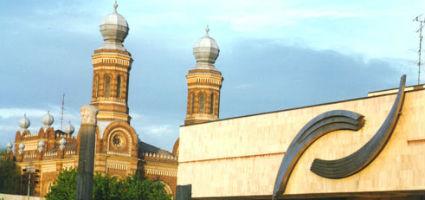2024. May 4. Saturday
Szombathely Gallery - Szombathely
 |
Address: 9700, Szombathely Rákóczi F. utca 12.
Phone number: (94) 508-800
E-mail: keptar@int.szombathely.hu
Opening hours: Wed-Sun 10-18
|
The exhibition has closed for visitors.
2015.03.20. - 2015.04.19.
Museum tickets, service costs:
|
Ticket for adults
|
1000 HUF
|
|
|
Ticket for students
|
500 HUF
|
|
|
Ticket for pensioners
|
500 HUF
|
In the preservation of historic knowledge and passing it on in addition to official history teaching, collective memory has always been of great importance and object of creative folk art, as well as the works of folk poetry representing that. Considering great figures of our history and events, we can see that the objects and texts relating to the 1848-49 Revolution and Civil War of Independence are of very special importance.
In some respect, it is seen as a continuation of this traditionally when we study the changes in interpretation of Hungarian crown crest or the '48 National Guard armband, and rosettes.
The 1848-49 civil revolution regained to the people our national symbols that were forced to be forgotten after the Rákóczi freedom fight, making the House of Habsburg declare the article XXI in 1848 in which the monarch for the first time said that "the national colours and the ancient rights of country coat of arms be restored." These symbols of freedom soon became a mobilizing force, and at the time of the autocracy became the national symbol of resistance. The depiction of the coat of arms with the crown on it was present in the life of people in almost all possible objects, including everyday objects or those used during celebrations as well.
"Tri-colour silk flags are extended,
They mean freedom for Hungarians,
Sweetheart have your clothes sewn of three colours,
If you love your country with all your heart."
„I will have a steel sword made for myself,
The coat of arms of my country will be carved in it,
I cut out its handle of a walnut
I will have the name of Lajos Kossuth carved in it"
Making coat of arms decorated with the crown can be traced back to the 1950's.In the showcase, an ornamental box made by the Kossuth prize awarded artist Antal Kapoli (1867-1957), the shepherd honoured with the title 'Master of Folk Art' is on display. one of our treasures. Ornamentation on the surface of box shows are of the finest examples of Transdanubian shepherd carving. The plant ornamentation covers the entire surface. The coat of arms is an integral part of it, making the box unique and impossible to repeat
In some respect, it is seen as a continuation of this traditionally when we study the changes in interpretation of Hungarian crown crest or the '48 National Guard armband, and rosettes.
The 1848-49 civil revolution regained to the people our national symbols that were forced to be forgotten after the Rákóczi freedom fight, making the House of Habsburg declare the article XXI in 1848 in which the monarch for the first time said that "the national colours and the ancient rights of country coat of arms be restored." These symbols of freedom soon became a mobilizing force, and at the time of the autocracy became the national symbol of resistance. The depiction of the coat of arms with the crown on it was present in the life of people in almost all possible objects, including everyday objects or those used during celebrations as well.
"Tri-colour silk flags are extended,
They mean freedom for Hungarians,
Sweetheart have your clothes sewn of three colours,
If you love your country with all your heart."
„I will have a steel sword made for myself,
The coat of arms of my country will be carved in it,
I cut out its handle of a walnut
I will have the name of Lajos Kossuth carved in it"
Making coat of arms decorated with the crown can be traced back to the 1950's.In the showcase, an ornamental box made by the Kossuth prize awarded artist Antal Kapoli (1867-1957), the shepherd honoured with the title 'Master of Folk Art' is on display. one of our treasures. Ornamentation on the surface of box shows are of the finest examples of Transdanubian shepherd carving. The plant ornamentation covers the entire surface. The coat of arms is an integral part of it, making the box unique and impossible to repeat